When I selected an Amex Platinum card in the #3Cards3Continents challenge, I knew what I didn’t want to do with the points. Greg had already announced his intention to book an ANA Round the World award, so I didn’t want to use the same Amex transfer partner in the same way. Instead, I decided to dig into a program that unveiled an entirely new award chart during the pandemic that really excites me: Air Canada Aeroplan. The Aeroplan award chart can be an amazing value for those looking to string together a trip to multiple far-flung destinations — particularly if you are someone who would enjoy a couple of single-day stops and taking “the long route”. If you’d like to make it to at least 3 continents on a single credit card welcome bonus, this might be the program for you.
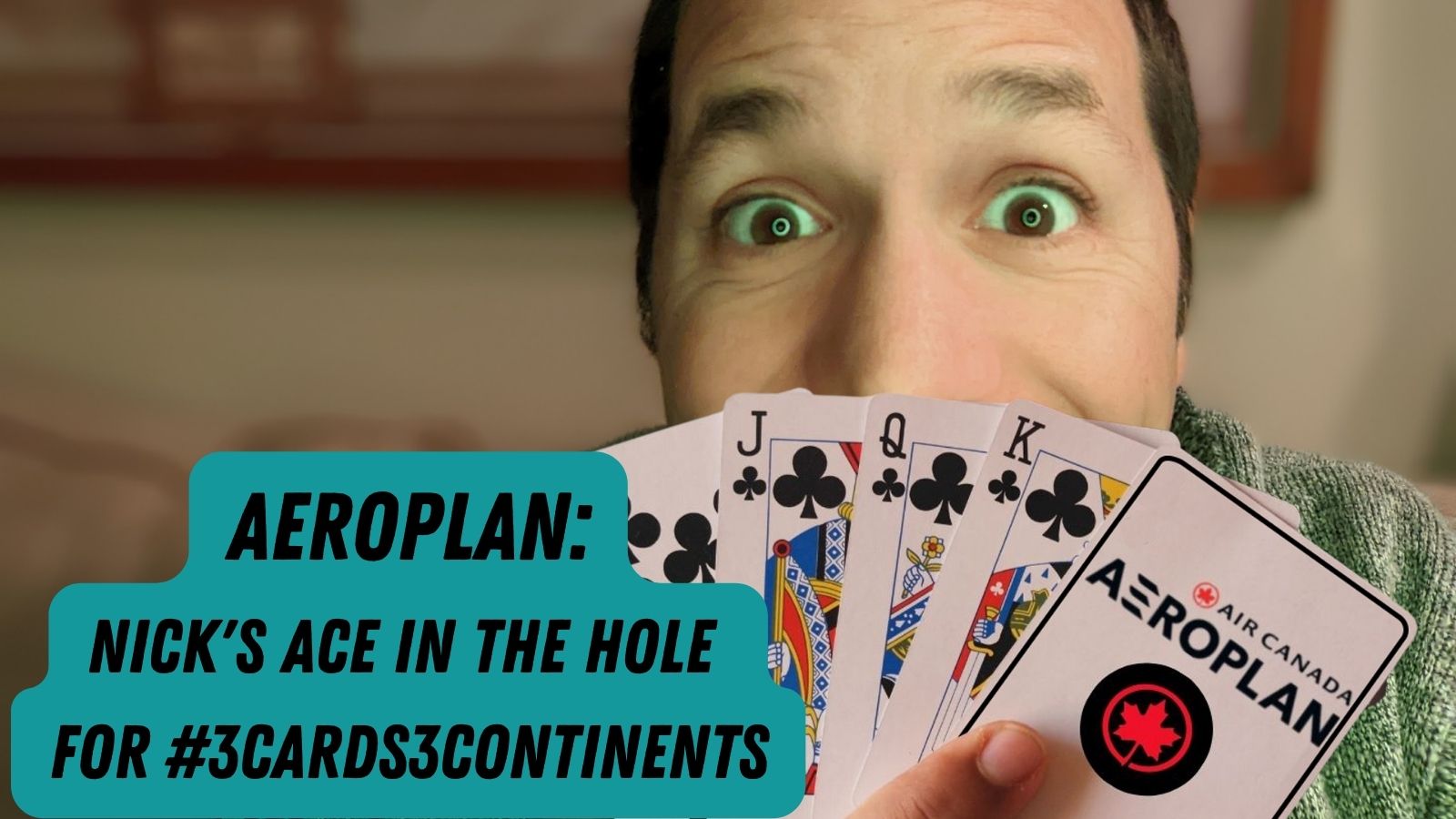
The sweet spot that excites me most: the US to the Pacific Region
I’m going to cut to the chase so that I can create a couple of example scenarios: the best deal on the Aeroplan award chart is flying from the US to the Pacific zone in business (or maybe first) class if you can add a stopover to your journey.
As a reminder, Aeroplan splits the world into four different zones:

Award pricing depends on a combination of which zones you connect between origin and destination and cumulative distance flown. If you are flying from the North America zone (in red above) to the Pacific zone (the purplish color), you will refer to the “Between North America and Pacific zones” pricing chart (shown below; see the full award chart here) and the price you pay will be based on the cumulative distance of all of your flights.
The reason for my excitement is because of the spot I’ve marked below:
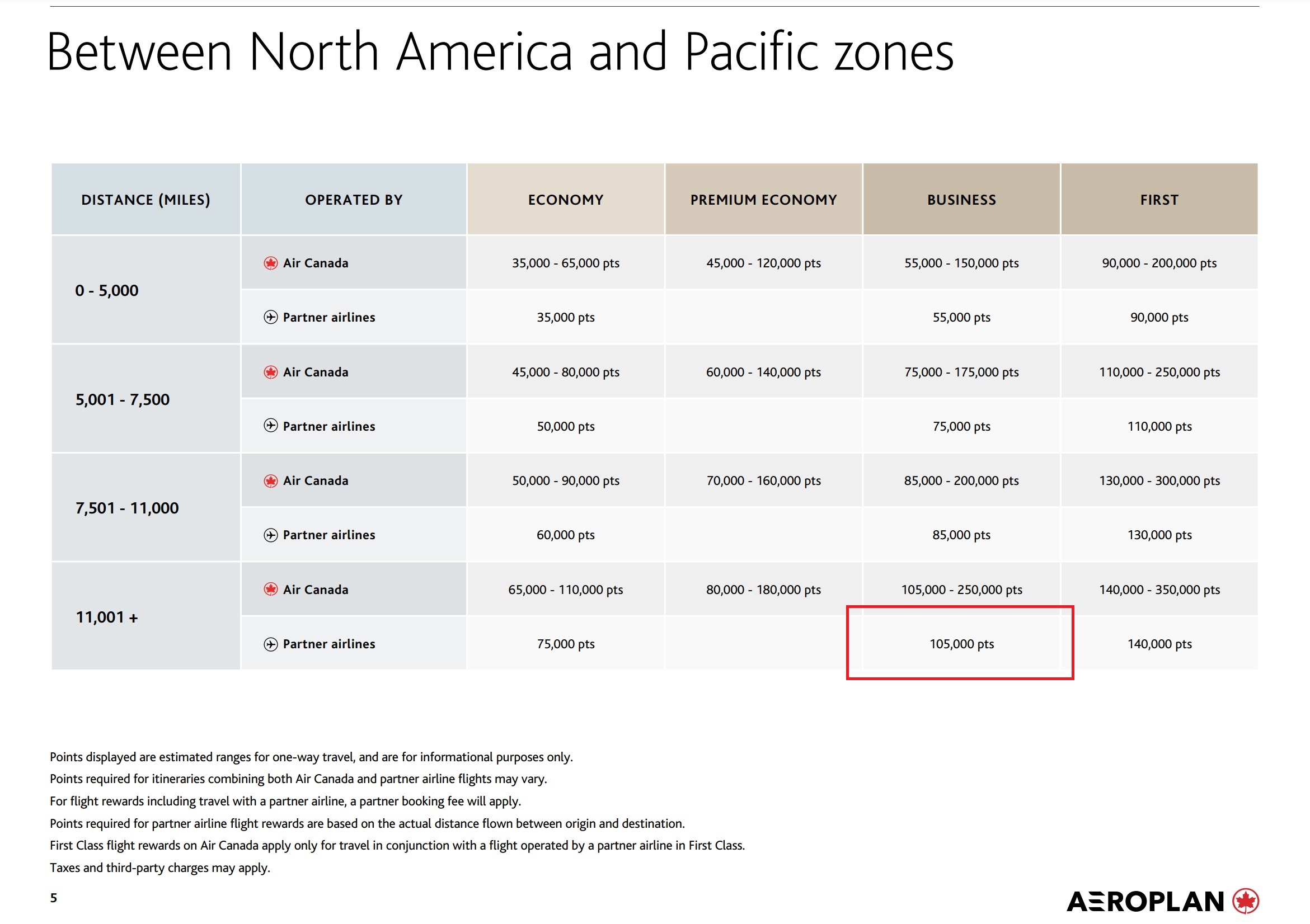
If you’re an award chart novice, maybe paying 105,000 miles one-way from the US to Asia in business class sounds reasonable to you. However, award booking veterans likely look at this as a subpar price — after all, there are plenty of ways to get to Asia or the South Pacific for fewer miles than that.
But if you’re an out-of-the-box type of person who would be happy to visit four or five different countries / continents for a short time and/or an aviation enthusiast who would like to sample four or five different airline products en route to your destination, it doesn’t get much better than this award chart sweet spot. In fact, this is arguably better than ANA’s famed round-the-world chart.
To understand why this sweet spot is so exciting and why it has led to day after day of me spending literally hours upon hours imagining my possibilities for the #3Cards3Continents challenge, you have to understand the stopover policy, routing rules, and partnerships that make Air Canada special.
Add a stopover to a one-way award for 5,000 miles
The simplest piece of the puzzle is Aeroplan’s stopover policy: you can add a stopover to a one-way award for just 5,000 miles. That can be a great deal.
For instance, let’s say that you want to travel to Bangkok, Thailand, but you’d also like to stop in Europe for a little Christmas Market shopping before you hit the tropics of Thailand. Aeroplan will let you do that!
As an example, you could take this itinerary on December 4,2022 from New York (JFK) to Warsaw, Poland (WAW) on LOT Polish and then from Warsaw to Vienna on Austrian Airlines all in business class (ignore the award pricing below as it assumes separate trips – I’ll cover the real pricing in a moment, this is just meant to illustrate real-world availability):

Then, after a few days in Vienna, you could continue on December 9th by flying from Vienna to Frankfurt on Austrian and then to Bahrain and onward to Bangkok on Middle Eastern carrier Gulf Air all in business class:

The total distance of that itinerary would be 11,107 miles flown:

Since the origin is in North America and the destination is in the Pacific zone and the total distance flown is just over 11,000 miles, you’ll pay 105,000 Aeroplan miles + 5,000 miles for the stopover — hitting two destinations on entirely different continents and ends of the cultural spectrum and 3 different airlines entirely in business class for just 110,000 total miles. Taxes & fees vary a bit depending on your stopover point but are just taxes & fees, no surcharges. That’s pretty cool!
But how far can we stretch that?
“Pretty far” is the answer.
Note that complex awards, including any awards with a stopover, must be booked over the phone at 800-361-5373. You can select a multi-city search online, but that will price awards separately and only allows two legs of the trip to be searched at a time. You need to call for the types of awards discussed in this post.
Generous routing rules and wide partnerships
Based on my experience thus far, Aeroplan has what have to be the most generous award routing rules imaginable.
The above example baked in a stopover in Europe en route to Thailand. That seems at least kind of intuitive as it is clearly “on the way” to Bangkok. What if you want to take the long route?
For instance, in the example above, we did a little backtracking from Warsaw to Vienna and from Vienna to Frankfurt, but what if you also overshoot the destination and then fly backwards a bit? Let’s say you’d like to fly from New York to Vienna for a few days and then continue on to Abu Dhabi and Singapore (on Etihad) and then Bali (on Singapore) and after spending nearly 24 hours in Bali you’d like to continue on to your final destination, Bangkok. You can do that.
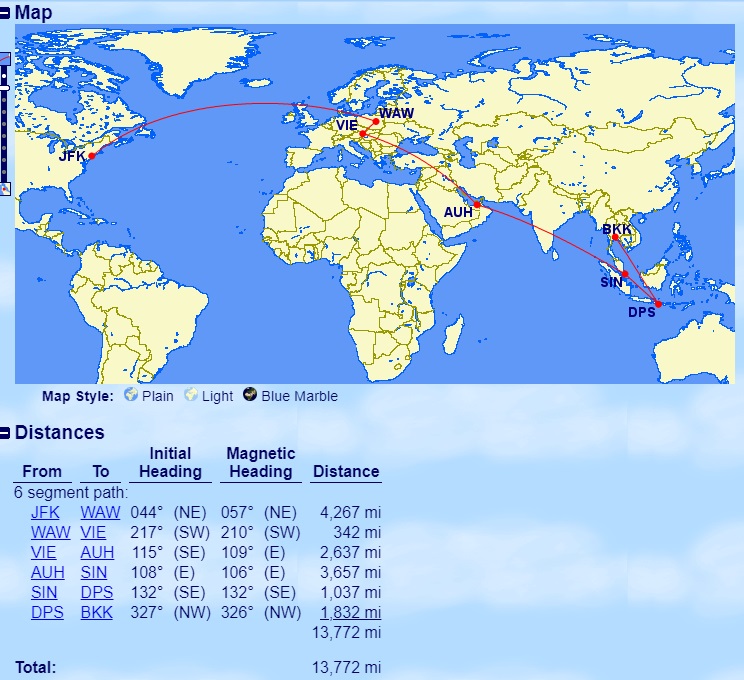
Here’s what the flights would look like for that:



All of that could be yours for a total of 110,000 Air Canada Aeroplan points (taxes will be in line with what you’d expect on an international trip — likely in the $100-$150 range based on my experiences thus far). With this trip, you would get:
- A few days in Vienna
- The chance to fly LOT Polish, Austrian (only intra-European in this case), Etihad, Singapore, and Thai all in business class on a single ticket.
- 6.5 hours to explore the famed Singapore Changi Airport (dip in the pool, anyone?)
- A nearly 24hr stop in Bali
- A final destination of Bangkok
- No carrier-imposed surcharges
That last part is important: unlike Greg’s ANA round-the-world award, those booking through Aeroplan don’t have to worry about how to avoid surcharges since Aeroplan does not pass on carrier-imposed surcharges. And unlike booking an ANA round the world award, you are not limited to Star Alliance carriers. Air Canada has more airline partners than any airline in the world. In addition to the 26 members of the Star Alliance, you can mix and match in partners like:
- Etihad
- Gulf Air
- Oman Air
- Vistara
- Air Dolomiti
- Air Mauritius
- Air Serbia
- Azul Brazilian
- GOL
- Virgin Australia
- and more. See the full list of partners here.
The reach of Aeroplan’s partners is incredible.
The best part is that the limits are not very limiting at all.
For instance, you may look at the itinerary above and think that the “backtrack” from Warsaw to Vienna is reasonable enough, but what about flying all the way to Singapore and Bali in order to get to a destination of Bangkok? Surely there is a more direct path possible. Will Aeroplan let you backtrack in the middle of an award and also overshoot your destination?
Thankfully, Aeroplan’s generous Flight Rewards Policy says this about taking “the long route” to your destination:
Flight Reward itineraries built in a circuitous manner may be permitted so long
as the cumulative flown distance between the origin and destination does not
exceed twice the non-stop distance for a given direction of travel.
In the example above, my origin is New York(JFK) and my destination is Bangkok. The “straight line” distance from New York to Bangkok is 8,677 miles.
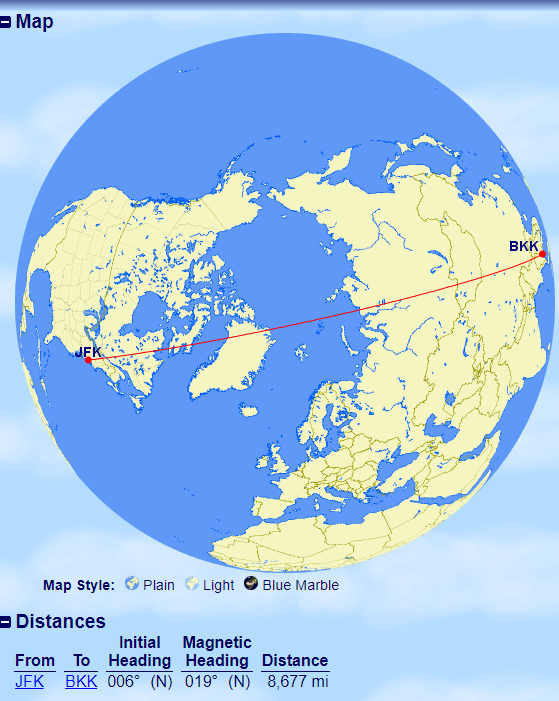
If I want to build a complex itinerary with a stopover, that means I can noy fly more than 8,677 miles x 2 = 17,354 total miles flown.
As you can see above, the sample itinerary I built comes in at 13,772 miles flown — more than 3,500 miles short of the limit. In other words, I could fly even more “out of the way” by a margin of more than the coast-to-coast width of the United States and still be within the rules. That’s pretty amazing.
When it comes to backtracking, you can not backtrack through the same connecting airport, city or country.
Within a single direction of travel, backtracking via the same connecting airport, city or country is not permitted
That last rule prevents something like this, which almost crosses both the Atlantic and the Pacific.
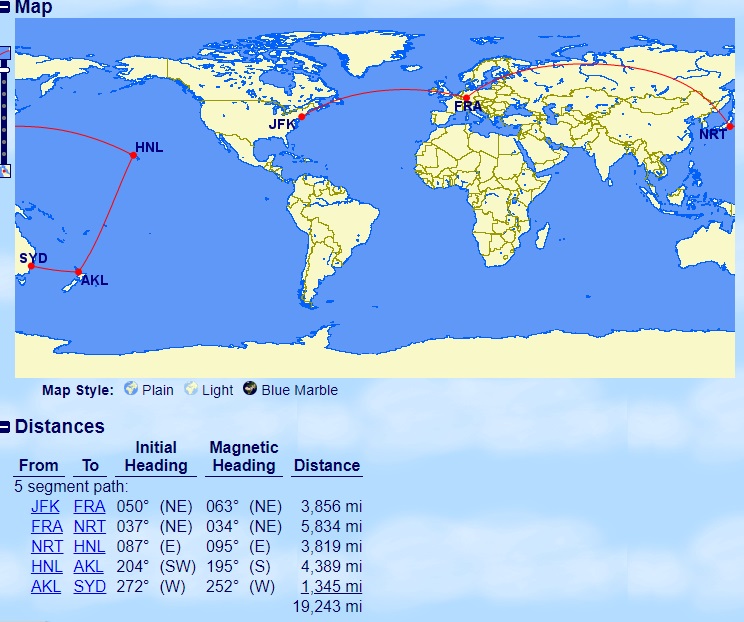
Amazingly, the route above crosses both the Atlantic and at least half of the Pacific and manages to ring in at less than double the distance from New York to Sydney (and at only 5 segments, maybe you could build on something more on Virgin Australia!). Unfortunately, I think the itinerary above would not be possible because Aeroplan’s award rules prevent backtracking through the same country. I think that the stop in Honolulu (same as the country of origin of the ticket) wouldn’t work. It sure does get the creative juices flowing though (Could you start in Toronto and accomplish that? Hmmmm……)
Of course you are only allowed 1 stopover (of more than 24 hours), but layovers can be up to 24 hours (more than 24 hours constitutes a stopover and you are only allowed one of those in each direction). Still, especially because of Air Canada’s unique mix of partners both within and beyond the Star Alliance, that makes it possible to stretch an award pretty far. While alliance partners often time flights to coincide with reasonably short layovers, non-alliance partners often present the opportunity for really long layovers between flights if your interest is in getting a taste of multiple destinations.
The key limiting factor is that you are allowed a maximum of 6 segments per direction of travel. In short, you can have a maximum of 6 flight segments on a one-way award. That will limit the upper bounds of the “circuitousness” of your award.
Connecting via third regions is fine
Whereas some award charts restrict the ability to fly from Zone A to Zone B by connecting in a third region (“Zone C”), Air Canada has no problem with allowing you to transit other zones. From the Flight Reward Policy:
For connecting itineraries with an origin and destination located in two different
travel zones of the Aeroplan Flight Reward chart, connecting via a third zone is
generally permitted if it meets the other conditions outlined in this document.
However, the following exceptions apply:• North America to/from Europe: must travel across the Atlantic Ocean
• North America to/from Middle East: must travel across the Atlantic Ocean
• North America to/from South America: must travel wholly within
the Western Hemisphere
Those rules are pretty simple and allow for really broad liberties. For example, travel between North America and the Pacific region can happen via either the Atlantic or Pacific oceans.
Again, this fits in nicely with Air Canada’s strengths: they have some really interesting partnerships (and with the announcement of a coming partnership with Emirates, it sounds like they will soon be partnered with most of the glitzy Middle Eastern carriers). Being able to transit a third region makes it very easy to combine carriers based in different regions on a single award.
Watch out for mixed cabin itineraries
One major caveat for those who will take to the Aeroplan website to search for awards is to watch out for mixed-cabin itineraries. Air Canada will show any itinerary with even a single very short leg in business class as a “mixed cabin” itinerary even when only a very insignificant part of the trip is in business class.
The good news is that you don’t need to click on every mixed cabin itinerary to find the ones that might actually be worth considering.
For starters, Air Canada color-codes mixed cabin itineraries like this:

Those that say “Mixed cabin” in red only include business class on fewer than 50% of the itinerary. I generally don’t even bother looking at those (some can be as low as like 7% in business class and I figure that if more than 50% is not in business class, it means that the long-hauls that really matter likely aren’t in business). You can find out how much of the itinerary is in one cabin or the other by mousing over the award price:


Clicking on the award price will expand more detail, where you can find which leg(s) are in economy class.

That can be useful when it’s a near split and you want to know which leg is not available in business class.
Again, I typically just totally ignore mixed cabin results where the words “Mixed Cabin” are in red and just focus on those that are not mixed cabin or that say mixed cabin in black (but then I need to check the details).
Also keep in mind that while the search engine is excellent, it won’t necessarily show every possible itinerary from Point A to Point B, so you may need to split up your trip and search leg-by-leg if you want to piece together something particularly complex.
So what will I do?
I’m not yet ready to divulge my plans for the #3Cards3Continents challenge, but the examples above should provide some inspiration to imagine the possibilities. With just the welcome bonus of the Schwab Platinum card I picked in the second round of the draft, I could use 105,000 miles to fly any of the itineraries above (without a stopover) to cross the Atlantic and visit Europe and Asia and maybe even Oceania all in business class. Thanks to the fact that I selected the American Airlines Aviator Business card in Round 3, which features a welcome bonus of 80,000 miles, I could fly back home across the Pacific Ocean and to my point of origin in business class — completing a round-the-world trip with multiple stops on 3 continents….without even touching my Capital One Venture Miles except for the (very modest) award taxes. Then I could spend the rest of the week flying back and forth to Hawaii with the Turkish sweet spot. Sure, I could meet the 3 continent requirement and also complete a simple circumnavigation of the world in business class within a week’s time without breaking a sweat. But that would be too easy . . .





You sure can write and capture your audience. Hope you have a safe trip and enjoy yourself to the fullest. Can’t wait to see it all
Nick,
Thanks for the post, It has the mind whirling.
For my plan it wont allow me to do it on one ticket but the stopovers will still work in our favor.
Like you Im ok seeing a place in a day, however not via a plane ride. We enjoy doing so on cruises, (I fit more of your wife’s style, I need and want my solid sleep) with a stopover in other places that we want to see for longer.
Example of how we will use Aeroplan for a sort of RTW trip (not sure of the directions etc) but will look something like this…
US-Italy-Australia (Stop over to see Italy/Switzerland/Germany/France)(Cruise in Australia)
Australia-New Zealand-Japan (Stop over in New Zealand)(Cruise in Japan)
Japan – ?? – Hawaii (Cruise in Hawaii)
Hawaii to US —Maybe even a TransPacific cruise from Hawaii to US
Haven’t laid it all out yet, but thanks for sharing all the details of Aeroplan to confirm almost anything is possible!
Nick! Need you input.
I recently booked a couple of award tickets through Aeroplan for the first time.
I found myself facing seat selection fees for our family of 5 on top of the awards.
Am I missing something? Is that standard?
Hi Nick, Excellent post as usual. I’m betting you’ll win this competition. Is it possible to squeeze in more than one stopover?
Hi Nick great information. The question I have is I have status with united and when using united to find flights for the aeroplan trip some show up as only being able to be seen because of my status. Will those flights show up with the aeroplan rep when I call to book ? Trying to go Newark to Cape Town for stopover then on to Bangkok. Then returning from Bali with stopover in Morocco ending in Palm Beach.I agree with some of the comments my trip is 3-4 month trip, not looking for the 20 hour stays !
No, partner airlines can not book space that United reserves for elite members.
6 hours in one place, 24 hours in another… That does not sound like a trip I would take or one I would vote on.
Different strokes for different folks!
My money is on Stephen Pepper….. good odds at Fanduel
Wow Nick! I love this post and the examples you gave. How did you know that I wanted to visit both the Christmas markets and SE Asia in one trip??? Now I know a great way to do it with Aeroplan’s generous stopover and routing rules! Thank you!!!
I did have a question. Since you will only be working with 106k MR points, I’m assuming no you can’t add a stopover. Is that correct?
Whatever you end up doing for this challenge, I can’t wait to see it!
Oh wait. Nvm. I forgot that you could potentially cash out $72 worth of your Capital One points to buy 4,000 Aeroplan miles with the current promotion and get a 50% bonus (1.8c per point).
Aeroplan is a Capital One transfer partner 🙂
Oh. That’s right ♂️
Great post Nick! Pretty amazing that you can book this segment by segment if you wanted to.. and up to 6 segments.. that’s very generous. On your first itinerary, if you could find a slightly more direct route you could even do this trip for 90k points as you were only 108 miles over.. its probably more fun to do the second itinerary and add some slightly less than 24 hour layovers.
I’m sure that you know this but forgot to mention it but when searching for flights, you can go to options and select “Exclude mixed cabin” so it doesn’t even show up in your search.
This made me miss the old US Airways 90K *roundtrip* award to Asia with generous routing rules.
Nick you are a genius!
As usual, wonderful post. Thank you Nick!
Sharing a real-world itinerary I booked 3 days ago: 10.9K miles in J for 90K MR + $150 taxes [YUL-LIS(stopover)-ZRH-AUH-SIN].
Would love to get feedback and advice from the community.
a) You’ve nailed it: the biggest game-changer here is pairing EU with a N.A.-Pacific award — best bang for the buck! Or basically any third city for that matter (e.g. fly from US to FRA, and visit SIN on the way). The main limitation is that 1 layover. Sure, max out your flying distance, while complying to AC’s “circuitous routing” rules. But who would really want to do 4 layovers/connections and 1 stopover on a single-bound trip even if it were entirely in J? For most travelers, I’d assume the biggest utility is in adding a free third zone. But I’d imagine some blogs/reviewers might find this useful to review as many J products as possible.
b) Critique my epic Aeroplan J booking!
– YUL-LIS on TP J (s/o 30D)
– LIS-ZRH on TP J (12h layover)
– ZRH-AUH-SIN on EY J
I am visiting LIS in the fall, arriving in SIN in Dec. Extensive researched narrowed my options to Aeroplan b/c I could arbitrage their destination-based award charts (unlike segment-based Avios) to fly US-EU-Asia but only pay for US-Asia miles.
Based in West Coast, so have to reposition to YUL because (a) I couldn’t find reasonable availability for SFO-YUL, and (b) that would bump me to the next award band @ 110K miles. Figured I could book a repositioning flight and redeem 22K UR miles @ 1.25cpp to pay for a SFO-YUL flight on AC.
I wasn’t able to find a reasonable award rate for YUL-LIS direct on AC, so had to do with TP. But very stoked about ZRH-SIN on EY.
Did I do OK? Ideally, I’d have preferred to include a SFO-YUL segment on AC J; and also shorten my connection in ZRH, and fly LIS-ZRH-SIN in the shortest time possible. The lack of availability will have me in ZRH for 12H connecting.
Is there any way I could optimize this flight further? Deets below.
FROM TO DURATION FLIGHT # CLASS AVAIL. AIRCRAFT
YUL LIS 10/28/22 22:40-10:15+1 6:35 TP254 J 9+ 32Q
LIS ZRH 11/28/22 18:45-22:35 2:50 TP928 J 9+ 321
ZRH AUH 11/29/22 10:30-19:30 6:00 EY74 J 2 789
AUH SIN 11/29/22 22:25-09:55+1 7:30 EY470 J 2 789
p.s. re: mixed cabins, pro tip — see mixed cabin %s visually rather than hovering, or color coding by clicking on More Options > Display > Mixed cabin : Visual Bar. It looks like this!
I saw this on Reddit immediately after reading this article this morning, and definitely wondered if I had stumbled upon Nick’s alt, lol.
In J means January????
J is a common abbreviation for business class because “J” used to be the most common fare class used by many airlines to indicate business class. That’s not necessarily the case anymore, but frequent fliers often use J as shorthand for business class still.
Great post! I knew the high level stuff already regarding Aeroplan but loved that you included some concrete examples
These FM challenges really drive some amazing discoveries and blog posts.